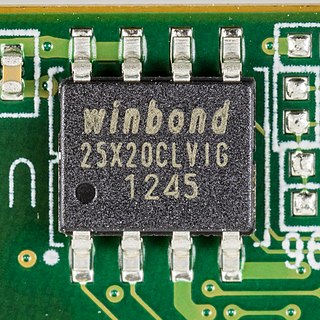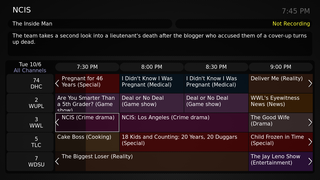The TF5800PVR and similar TF5800PVRt is the UK Freeview version of Topfield's TF5000PVRt, which is a personal video recorder (PVR) with twin tuners; it is possible to record two programs and view a third so long as all programs do not use more than two multiplexes. Firmware upgrades were distributed over-the-air using the normal FreeView distribution method, and are also available for Internet download.
Topfield devices are often referred to as “Toppys”.
The device has the features expected from a dual-tuner PVR, but also allows extensive software customisation by the use of TAPs (described below). Files (TV programmes, MP3 files, and operating files) can be transferred over USB between the PVR and a computer.
The TF5800PVR[t] was replaced by the TF5810PVRt with similar functionality, but which also supports HDMI output (from standard, but not HD, broadcasts—reception of Freeview HD channels requires a DVB-T2 receiver, which the TF5810PVRt is not). The latest factory firmware versions for both models incorporate some features equivalent to Freeview+.
The USB 2.0 socket allows files to be transported both ways between the device and a computer running transfer software written for this purpose. Microsoft Windows, Mac OS X, and some versions of Linux/Unix are supported. Files of any kind can be moved in both directions but the feature is mainly used
USB file transfer is rather slow. It can be accelerated to some extent by using the transfer software's Turbo mode and by using TAPs which eliminate unnecessary handshaking signals.
The functionality of the TF5800PVR can be enhanced via the use of Topfield Application Programs (TAP). TAPs are C programs, developed by users for users. They can be developed under Microsoft Windows using a Topfield platform cross-compiler (GCC for TAP) or the Cygwin GCC compiler.
TAPs are applications written using an API available free from the manufacturer. The API provides access to almost all features of the device: TAPs can access EPG information, change channels, start or stop a recording session, change pre-set recording timers, write text and draw graphics to the screen, and react to buttons pressed on the remote control. It is possible to write a useful program, adding useful functionality, in ten lines of C code.
TAPs have been written to provide many enhancements to the Toppy. Most are available as freeware. Although some technical users consider enhancement via TAPs to be the best thing about the device, the PVR works normally without any.
Firmware can be downloaded to a computer and transferred via USB to the PVR. Unlike the majority of electronics devices, many users do not recommend always updating to the manufacturer's latest firmware, instead recommending versions of firmware that have been debugged and enhanced by users. As of October 2013 [update] the Toppy website recommended TF5800PVR/PVRt firmware 5.13.65T, a modified version of August 2007 factory firmware 5.13.65. [1] The last firmware released by the manufacturer was the July 2008 5.14.09Plus. Different releases apply to the TF5810PVRt.
Patches to the firmware can be downloaded to a computer and transferred to the PVR.

TiVo is a digital video recorder (DVR) developed and marketed by Xperi and introduced in 1999. TiVo provides an on-screen guide of scheduled broadcast programming television programs, whose features include "OnePass" schedules which record every new episode of a series, and "WishList" searches which allow the user to find and record shows that match their interests by title, actor, director, category, or keyword. TiVo also provides a range of features when the TiVo DVR is connected to a home network, including film and TV show downloads, advanced search, online scheduling, and at one time, personal photo viewing and local music playback.

In computing, firmware is a specific class of computer software that provides the low-level control for a device's specific hardware. Firmware, such as the BIOS of a personal computer, may contain basic functions of a device, and may provide hardware abstraction services to higher-level software such as operating systems. For less complex devices, firmware may act as the device's complete operating system, performing all control, monitoring and data manipulation functions. Typical examples of devices containing firmware are embedded systems, home and personal-use appliances, computers, and computer peripherals.
A digital video recorder (DVR) is an electronic device that records video in a digital format to a disk drive, USB flash drive, SD memory card, SSD or other local or networked mass storage device. The term includes set-top boxes with direct to disk recording, portable media players and TV gateways with recording capability, and digital camcorders. Personal computers are often connected to video capture devices and used as DVRs; in such cases the application software used to record video is an integral part of the DVR. Many DVRs are classified as consumer electronic devices; such devices may alternatively be referred to as personal video recorders (PVRs), particularly in Canada. Similar small devices with built-in displays and SSD support may be used for professional film or video production, as these recorders often do not have the limitations that built-in recorders in cameras have, offering wider codec support, the removal of recording time limitations and higher bitrates.

Hauppauge Computer Works is a US manufacturer and marketer of electronic video hardware for personal computers. Although it is most widely known for its WinTV line of TV tuner cards for PCs, Hauppauge also produces personal video recorders, digital video editors, digital media players, hybrid video recorders and digital television products for both Windows and Mac. The company is named after the hamlet of Hauppauge, New York, in which it is based.

Electronic programming guides (EPGs) and interactive programming guides (IPGs) are menu-based systems that provide users of television, radio and other media applications with continuously updated menus that display scheduling information for current and upcoming broadcast programming. Some guides also feature backward scrolling to promote their catch up content. They are commonly known as guides or TV guides.
Established in South Korea in 1998, TOPFIELD Co., Ltd. is a consumer electronics manufacturer making broadcasting receivers, other video and audio related apparatus. Their main business is making products such as set top boxes (STBs) and personal video recorders (PVRs) to be used with satellite television or digital television. Topfield have never manufactured televisions.

Sky+ is a discontinued personal video recorder (PVR) and subscription service from the satellite television provider Sky in the UK and Ireland. Launched in September 2001, it allows customers to record, pause and instantly rewind live TV. The system performs these functions using an internal hard drive inside the Sky+ set top box, an upgrade over the standard Digibox.

Windows Media Center (WMC) is a defunct digital video recorder and media player created by Microsoft. Media Center was first introduced to Windows in 2002 on Windows XP Media Center Edition (MCE). It was included in Home Premium and Ultimate editions of Windows Vista, as well as all editions of Windows 7 except Starter and Home Basic. It was also available on Windows 8 Pro and Windows 8.1 Pro as a paid add-on, before being discontinued in Windows 10, although it can reportedly be unofficially reinstalled using a series of Command Prompt commands.

SageTV Media Center, now open source, was a proprietary, commercial DVR and HTPC software for Mac OS X, Windows and Linux. It requires that the host computer have a hardware-based TV tuner card. The SageTV software has an integrated Electronic Programming Guide (EPG) that is updated via the Internet. The program provides a television interface for DVR, music, and photos on Windows and Linux. SageTV Media Center typically records in standard MPEG2, making it possible to transfer recordings to laptops or other devices. It also has a built-in conversion feature to transcode files into other formats compatible with iPod, PSP, cell phones and other portable devices.
The Hauppauge MediaMVP is a network media player. It consists of a hardware unit with remote control, along with software for a Windows PC. Out of the box, it is capable of playing video and audio, displaying pictures, and "tuning in" to Internet radio stations. Alternative software is also available to extend its capabilities. It can be used as a front-end for various PVR projects.

Yepp was Samsung Electronics' digital audio player brand until Samsung decided to retire most of their family brands in February 2011. From then on, their MP3 players were simply branded "Samsung" worldwide until they discontinued all of them in late 2013. The brand included a wide range of hard-drive based as well as flash-memory based players. The name is claimed to be an acronym for "young, energetic, passionate person".
The NSLU2 is a network-attached storage (NAS) device made by Linksys introduced in 2004 and discontinued in 2008. It makes USB flash memory and hard disks accessible over a network using the SMB protocol. It was superseded mainly by the NAS200 and in another sense by the WRT600N and WRT300N/350N which both combine a Wi-Fi router with a storage link.

A live USB is a portable USB-attached external data storage device containing a full operating system that can be booted from. The term is reminiscent of USB flash drives but may encompass an external hard disk drive or solid-state drive, though they may be referred to as "live HDD" and "live SSD" respectively. They are the evolutionary next step after live CDs, but with the added benefit of writable storage, allowing customizations to the booted operating system. Live USBs can be used in embedded systems for system administration, data recovery, or test driving, and can persistently save settings and install software packages on the USB device.
tvtv Services, trading as tvtv, is a consumer-oriented pan-European electronic programme guide (EPG) service provider, owned by the arvato AG subsidiary rtv media group GmbH since January 2013. It was formerly broadcast on Freeview channel 304 until 30 October 2008.
This is a comparison of digital video recorder (DVR), also known as personal video recorder (PVR), software packages. Note: this is may be considered a comparison of DVB software, not all listed packages have recording capabilities.

GB-PVR was a PVR application, running on Microsoft Windows, whose main function was scheduling TV recordings and playing back live TV. GB-PVR is no longer under active development and has been superseded by NextPVR, also known as nPVR.

Freeview is the brand name of the digital terrestrial television platform in Australia intended to bring all of free-to-air (FTA) broadcasters onto a consistent marketing platform, to compete against subscription television, in particular Foxtel. The strategy coincided with the expansion to 3 digital channels for each FTA network and the planned phasing out of analog television in Australia. Important services from Freeview include its free-to-air channels with an enhanced EPG across all channels. Freeview also certifies televisions, set-top boxes and personal video recorders (PVR) which meet its standards.

A TV gateway is a television headend to a network UPnP router that receives live digital video broadcast (DVB) MPEG transport streams (channels) from terrestrial aerials, satellite dishes, or cable feeds and converts them into IP streams for distribution over an IP network.
VBox Home TV gateway is a network-enabled live TV tuner and PVR HDTV set-top-box produced by VBox Communications Ltd.
Enigma2, the second generation of Enigma software, is an application used in Linux-based Digital Video Broadcasting receivers or TV set-top boxes and Internet Protocol television receivers. It creates a graphical user interface to control the said devices using a remote control and provides features such as tuning available satellite transponders, cable channels and terrestrial television transmitters or accessing material via Internet Protocol television (IPTV), watching a TV program or listening to radio, time shifting, Digital video recorder, streaming media programs to other devices, etc. Other features are available through plugins – for example Electronic program guide (EPG), Hybrid Broadcast Broadband TV (HbbTV), access to TV archives and movie databases, playback of multimedia files, viewing photos, etc.